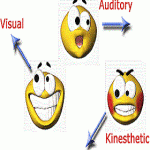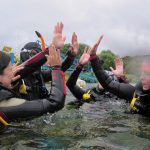In many parts of the world, Dive Centre managers want their Dive Instructors to speak more than one language. They want their Instructors to be able to communicate with their customers. But is it enough just to speak to future students in a language that they understand?
Are we really connecting with our customers? Have you ever heard that People interpret information in accordance with their learning styles? usually these fall into one of 3 main learning styles? Visual, Audio or Kinaesthetic?
When we look carefully at this, we find that unless we make sure that we are talking to people in their preferred style, very little learning will take place, and a lot of time will be wasted!
When my IDC Candidates first learn about this, they usually ask one of the following questions:
- What does Kinaesthetic mean?
- What style do you think that I am?
- Does any of this matter?
- If it does matter, then how can I improve my teaching style to make sure that I am communicating to all people?
I’ll try to answer some of these questions.
Let’s look at Visual learners first. Have you noticed that when you speak to some people, they often reply with a statement like: “I SEE what you mean”? or “I get the picture”?
Well, these people are giving a clear indication that they are VISUAL learners. When they say that they “SEE what you mean” they usually literally have an image in their mind of what is being discussed. These people often learn best by looking at pictures, videos or other images.
If, on the other hand, they reply ” I HEAR what you are saying” or “that rings a bell” or “That SOUNDS feasible” then they are giving an indication that they are AUDITORY learners. Auditory learners often prefer to read books, or listen to the spoken word to get information.
KINAESTHETIC learners on the other hand, are far more practical, and prefer to learn by doing things. They can often imagine the “feeling” of doing something before they actually try.
It’s important to remember that we don’t neatly fall into one or the other of these systems. We will probably fall into all 3 categories from time to time, but will generally have one dominant style.
So the next question is: Does any of this matter?
Well to answer this question, let’s look at a possible scenario in a Dive Shop.
Let’s imagine that a woman walks into a Dive Shop. She walks up to the assistant and says:
“I’ve just seen that BCD in the window, it looks just what I need! It’s the right shape, and the right colour! Can I take a closer look at it please?
Now the woman is clearly using terms like “look” “see” and “Shape” to suggest that she is a VISUAL person.
The man behind the counter, however, has been diving for many years. He is very Kinaesthetic, and answers:
“Good choice madam!” That BCD is an excellent model. It’s got a fantastic lift. When you’re at the surface, you can inflate it and it will hold you very high in the water.
The woman, is a little confused by this reply, but never-the-less takes a closer look. She studies the BCD, and then says:
“Well, it looks OK, but does it come in a lighter shade of blue than this? It don’t think that it will look right with my wet suit.
The assistant is slightly amused by this trivial reference to colour and replies:
Yes, I’m sure that it comes in other colours, but you need to experience how comfortable the Low Pressure Inflater feels in your hands. It’s perfectly designed. Just hold this in your hand and notice how easy it is to reach the buttons.
The customer, now even more confused than before, looks at the back of the BCD to see how the tank band will look on her cylinder once it’s fastened.
The assistant, sensing that the customer is not quite as enthusiastic as she was when she first walked in tries to redeem the situation by saying:
“Why don’t you just slip it on? You’ll feel how comfortable it is. You can imagine how secure you’ll feel when it is inflated.
The woman now takes one last look at the BCD and decides that on reflection, it’s not exactly what she wanted. She leaves the shop quite disappointed. The BCD looked really nice in the window, and although she can’t quite put her finger on why, she doesn’t think that it’s the BCD for her.
The shop assistant is also very disappointed. The customer was so enthusiastic when she first came into the shop. He felt that he couldn’t have helped her more; the BCD was an excellent model. He can’t really understand why she didn’t buy it.
So! we can clearly see that although they were both speaking in English, they weren’t speaking to each other in the same language! Neither could understand what the problem was, but they just knew that things “weren’t right between them”
It’s interesting to note that a lot of Divers are Kinaesthetic. You might be surprised to hear this. But if you were to ask a diver what their last dive was like, you might imagine that they would answer by telling you what they SAW.. But try it out!! ask a few divers that same question, and you’ll find that most will tell you how they FELT during that dive. They’ll use words like: Comfortable, Cold, Warm, Good Buoyancy, Frustrated, Cautious, Relaxed etc….
So, as PADI Divemasters, PADI Instructors or AI’s we need to make sure that we are communicating with all of our customers. Fortunately all PADI materials make sure that all learning styles are covered. Pictures, words and scenarios cover all of the bases.
But what about talking face to face? Do we have to analyse every customer? Do we have to work out which style to speak in? Well according to some books on teaching, this is exactly what they suggest we do! But of course in reality, this is very difficult and very impractical!
BUT the answer is very simple! All we need to do is to be empathetic with each of our customers. We just listen to what they say, and speak back using the same words as they use. Most of the time this is a very natural process. The important thing is to LISTEN and take an interest in WHAT the person is saying. We don’t need to analyse, nor evaluate, we just speak back naturally. It will work most of the time.
Good luck! you don’t need to do anything else other than be aware that people are different! We talk about this a lot on our EFR instructor courses, and also our PADI Instructor Development Courses.



